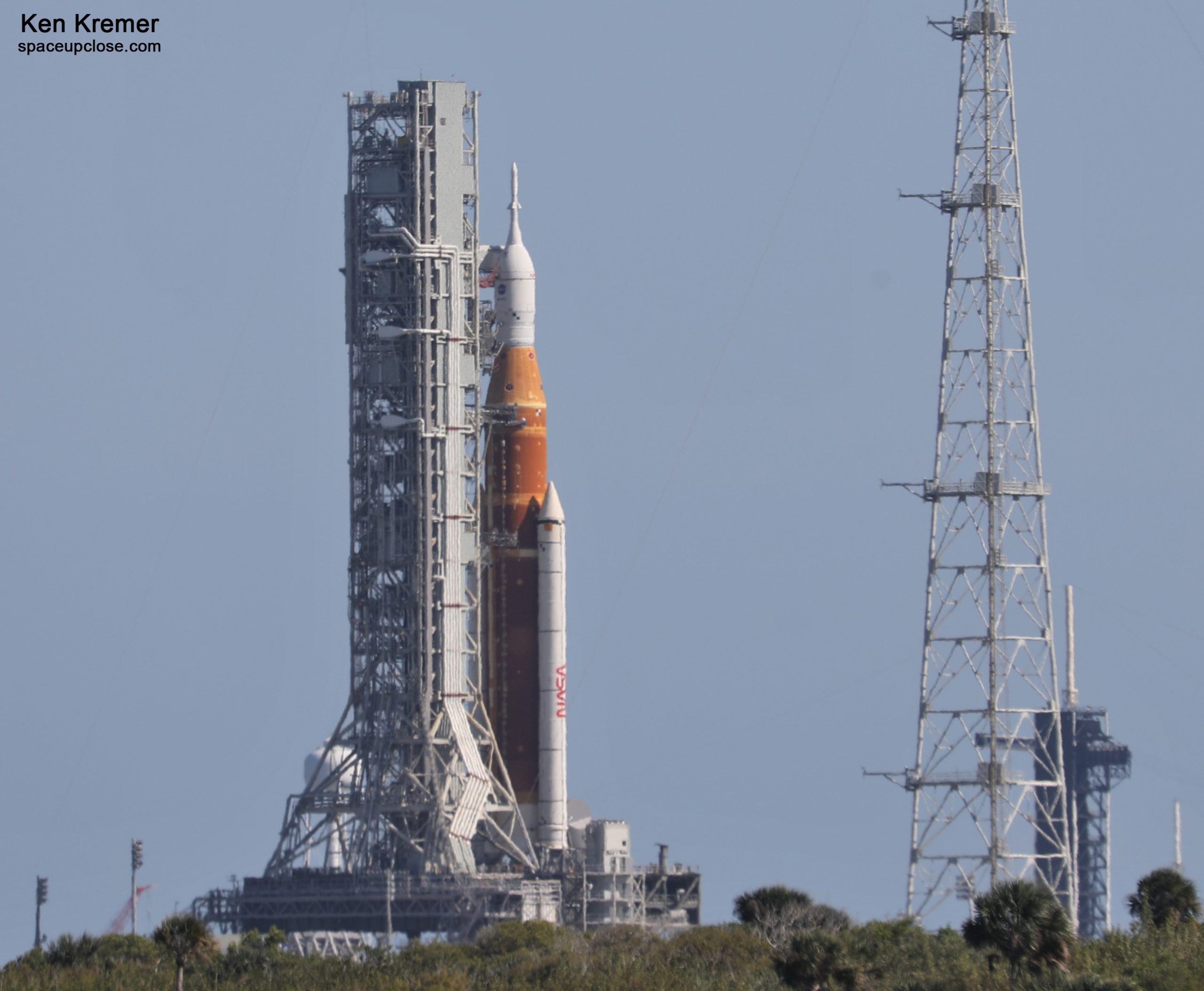
For SpaceUpClose.com & RocketSTEM
KENNEDY SPACE CENTER/CANAVERAL NATIONAL SEASHORE, FL – NASA has started the critical countdown and fueling test known as the Wet Dress Rehearsal (WDR) on April 1 as planned for the first ever Space Launch System (SLS) Mega Moon rocket rolled out to its launchpad atop the Mobile Launcher at the Kennedy Space Center (KSC) in Florida – but has encountered both weather and technical issues that have delayed the actual propellent loading after a scrub on Sunday, April 3.
The WDR is a practice countdown simulation, propellant fueling and verification of every activity on launch day except for ignition and liftoff – so its a critical learning process to help ensure all goes well on the real launch day for the unpiloted Artemis 1 lunar test mission as soon as early June.
A series of four lightning strikes hit the trio of lightning towers and catenary wires at the KSC pad 39B launch site on Saturday, April 2. They functioned perfectly to protect the rocket from lightning strikes.
“The lightning protection system consists of three nearly 600 foot tall towers that work together to protect the rocket from lightning strikes.”
“Engineers confirmed there were four lightning strikes to the lightning towers within the perimeter of Launch Pad 39B. Teams have determined the first three were low intensity strikes to tower two and are continuing to review data from the fourth strike, which was higher in intensity to tower one. At the time of the strikes, Orion and the Space Launch System (SLS) core stage were powered up and the solid rocket boosters and interim cryogenic propulsion stage (ICPS) were not. Teams currently see no constraints to proceeding with the test countdown timeline as planned and will continue procedures to power up the SLS boosters and ICPS overnight,” NASA said on April 2.
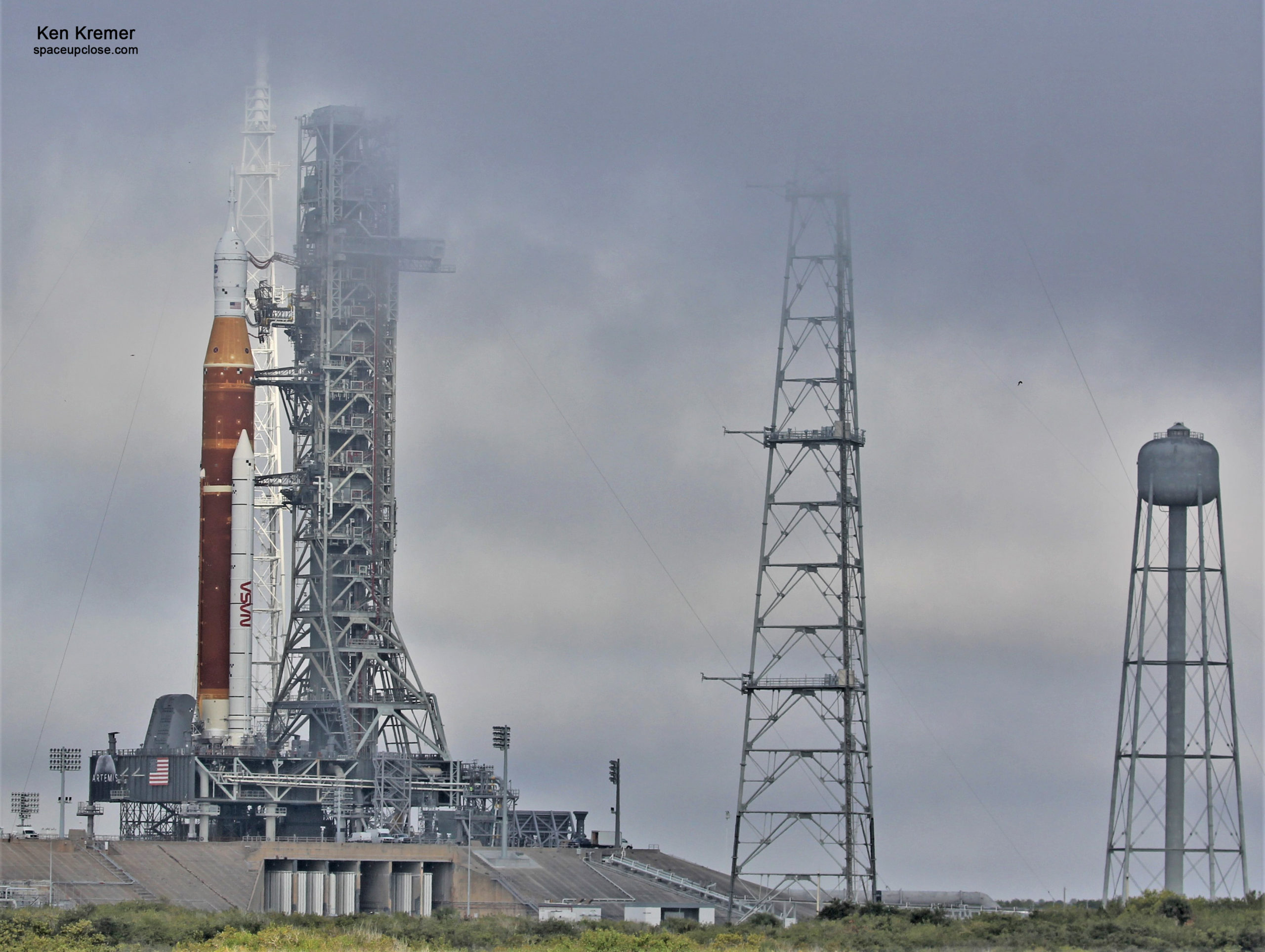
Both the primary and backup supply fans failed on the Mobile Launcher which are critical for keeping out toxic hazardous gases from enclosed work areas and forced the April 3 scrub.
“Teams have decided to scrub tanking operations for the wet dress rehearsal due to loss of ability to pressurize the mobile launcher. The fans are needed to provide positive pressure to the enclosed areas within the mobile launcher and keep out hazardous gases. Technicians are unable to safely proceed with loading the propellants into the rocket’s core stage and interim cryogenic propulsion stage without this capability,” said NASA on April 3.
We will have a detailed stories throughout.
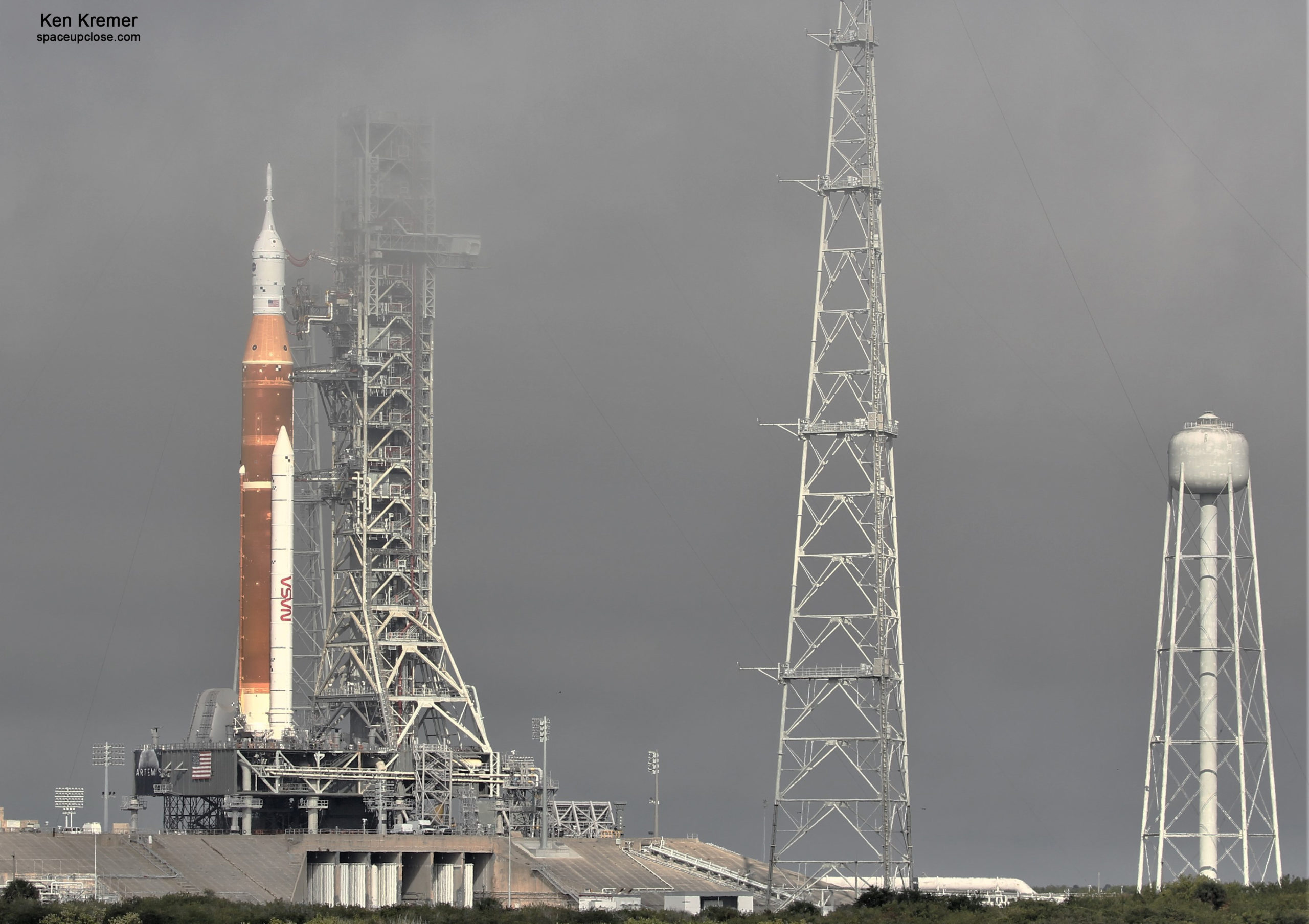
Enjoy our photos of the NASA SLS moon rocket vertical at pad 39B taken by the Space UpClose team of Ken Kremer and Jean Wright taken during and after rollout and different locations at KSC and offsite on Canaveral National Seashore
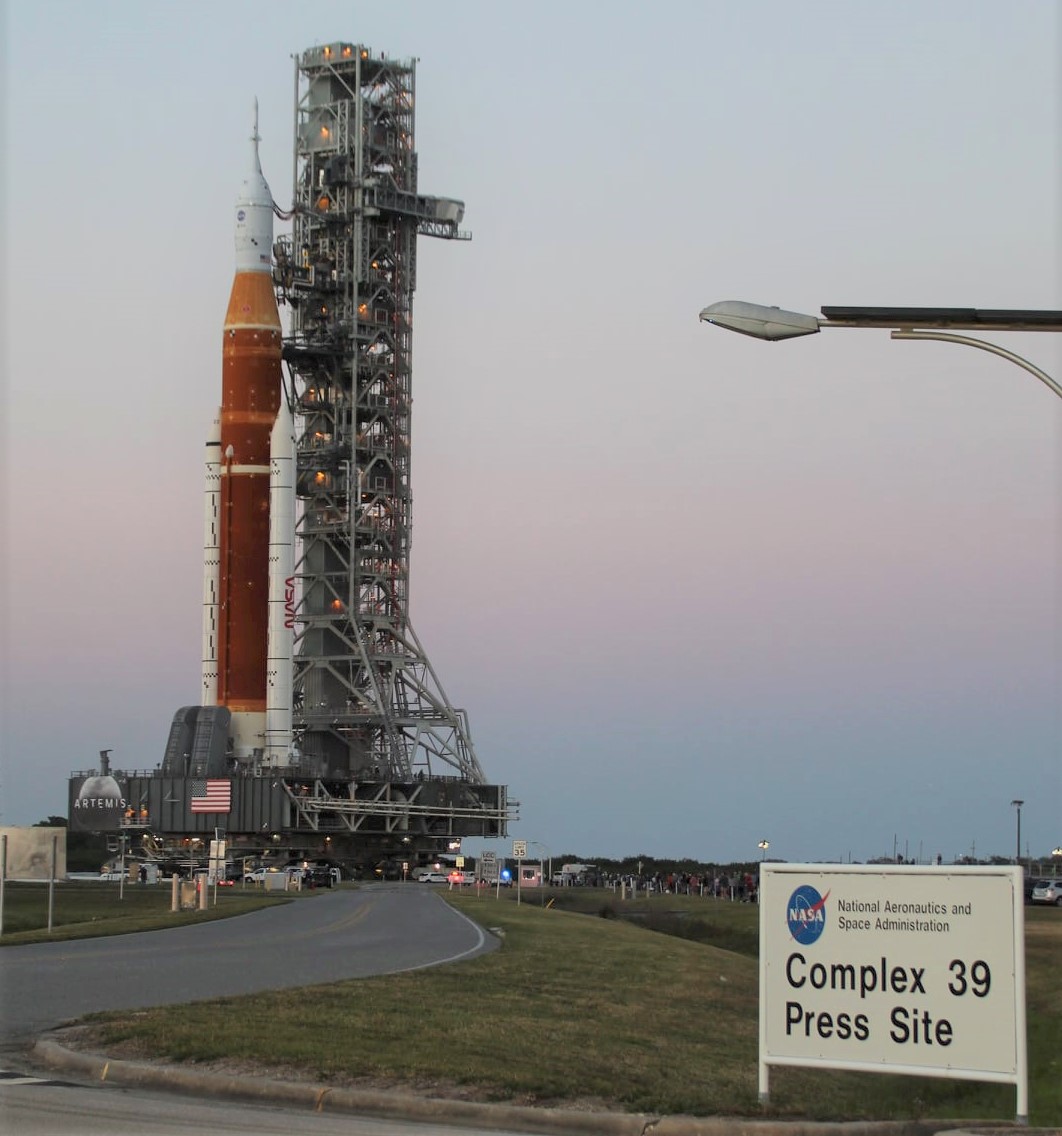
During the WDR the Artemis I launch team will “run through operations to load propellant into the rocket’s tanks, conduct a full launch countdown, demonstrate the ability to recycle the countdown clock, and also drain the tanks to practice the timelines and procedures the team will use for launch.”
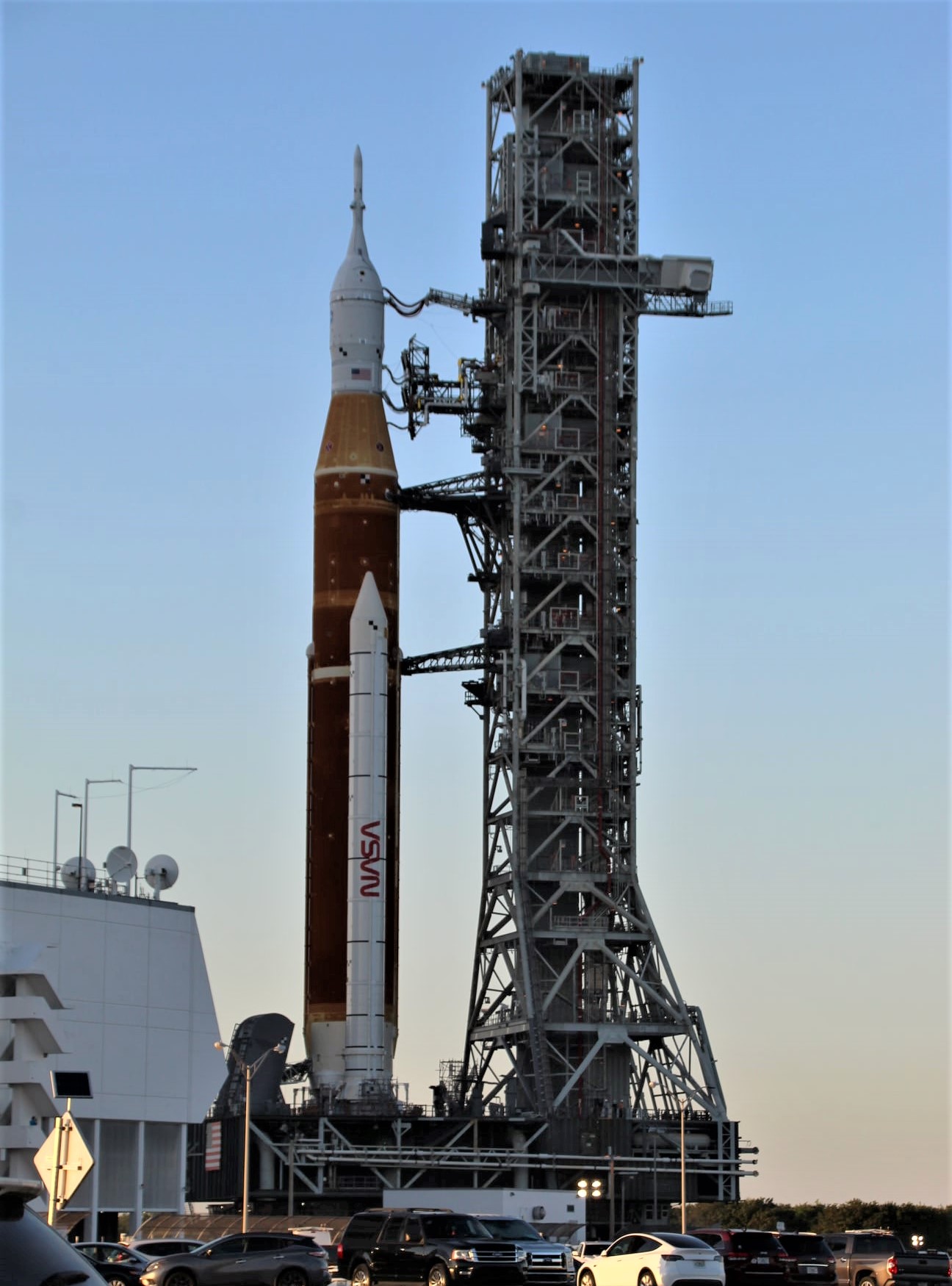
The WDR cryogenic propellant loading was targeted for April 3.
The SLS launch team call to stations took place as planned on April 1 for the then planned two day test.
The WDR was retargeted to April 4 and is now in progress after a milti-hour delay due to multiple early and concurrent technical issues with the fan system, gaseous Nitrogen supply and LOX temperatures and pressures and vent valve movements.
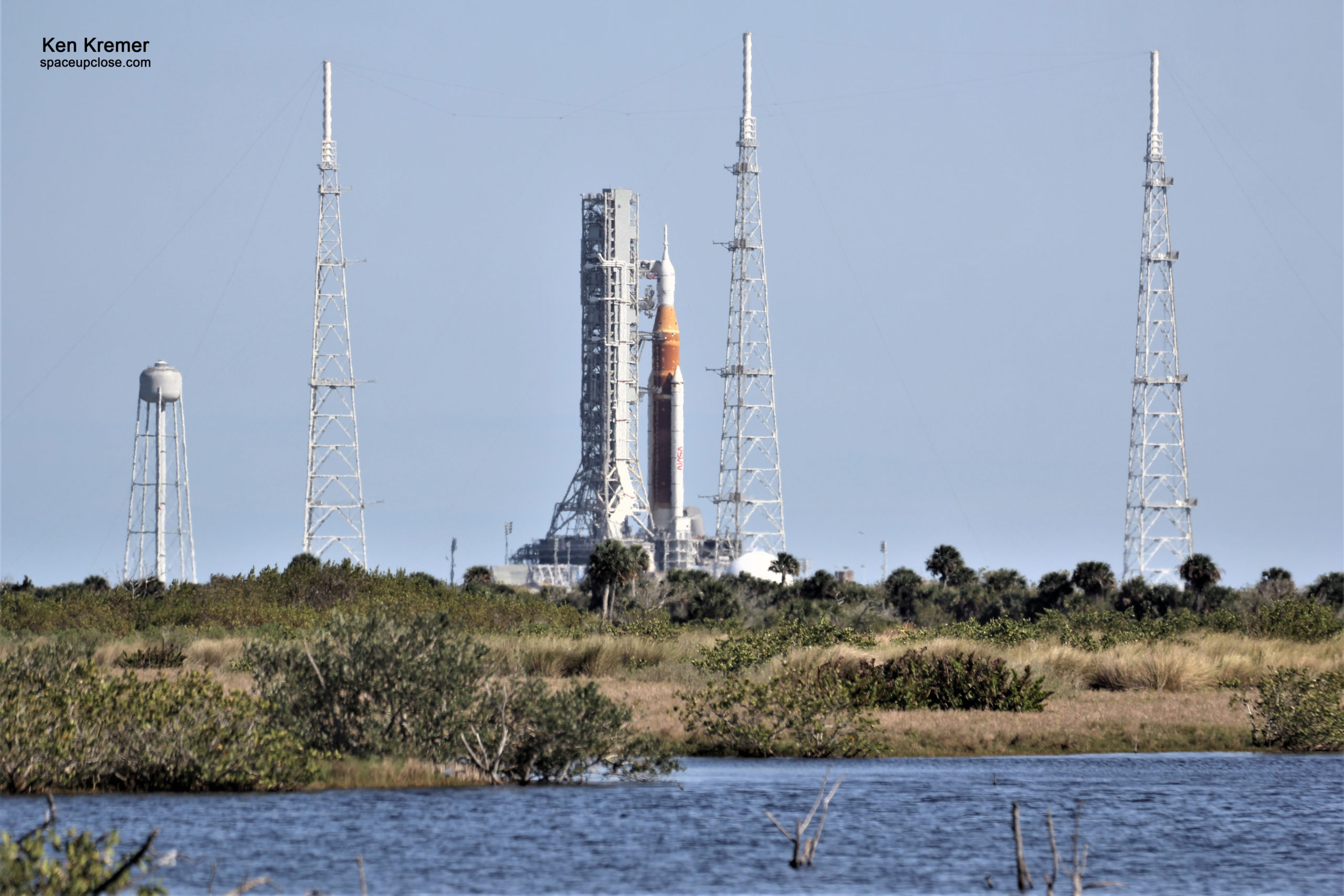
Both stages of SLS will be fueled during the WDR with over 700,000 gallons of propellants – including 196,000 gallons LOX and 537,000 gallons LH2.
The stages will be fueled with cryogenic liquid oxygen (LOX) and liquid hydrogen (LH2) that was planned to start around 7 a.m. EDT (1100 GMT) on WDR test day – but was delayed.
“Once propellant loading operations begin, liquid oxygen (LOX) and liquid hydrogen (LH2) will flow into the into the rocket’s core stage and interim cryogenic propulsion stage tanks and be topped off and replenished as some of cryogenic propellant boils off.”
“The team will also conduct leak checks to ensure propellant loading is proceeding as expected.”
The countdown dress rehearsal will proceed to the T Minus 33 second mark and then be intentionally aborted before engine ignition to demonstrate that the countdown can be recycled and then restarted to aborted a second time at T Minus 9.3 seconds, explained NASA Artemis launch director Charlie Blackwell-Thompson at NASA media briefings.
The propellant loading is expected to last about eight hours or so, said Blackwell-Thompson
“The approximately two-day test will run the Artemis I launch team through operations to load propellant into the rocket’s tanks, conduct a full launch countdown, demonstrate the ability to recycle the countdown clock, and also drain the tanks to give them an opportunity to practice the timelines and procedures they will use for launch.”
“During the rehearsal, controllers will count down to T-1 minutes and 30 seconds and pause to demonstrate the ability to hold for up to 3 minutes, then resume until 33 seconds before when launch would occur, then pause the countdown. Then they will recycle back to ten minutes before launch and conduct a second terminal countdown to approximately 9.3 seconds before launch, then end the countdown. Sometimes called a “scrub,” launch controllers may decide not to proceed with launch if a technical or weather issue arises during or prior to the countdown. At the end of the test, the team will drain the propellant to demonstrate the procedures that would be used during a launch scrub.”
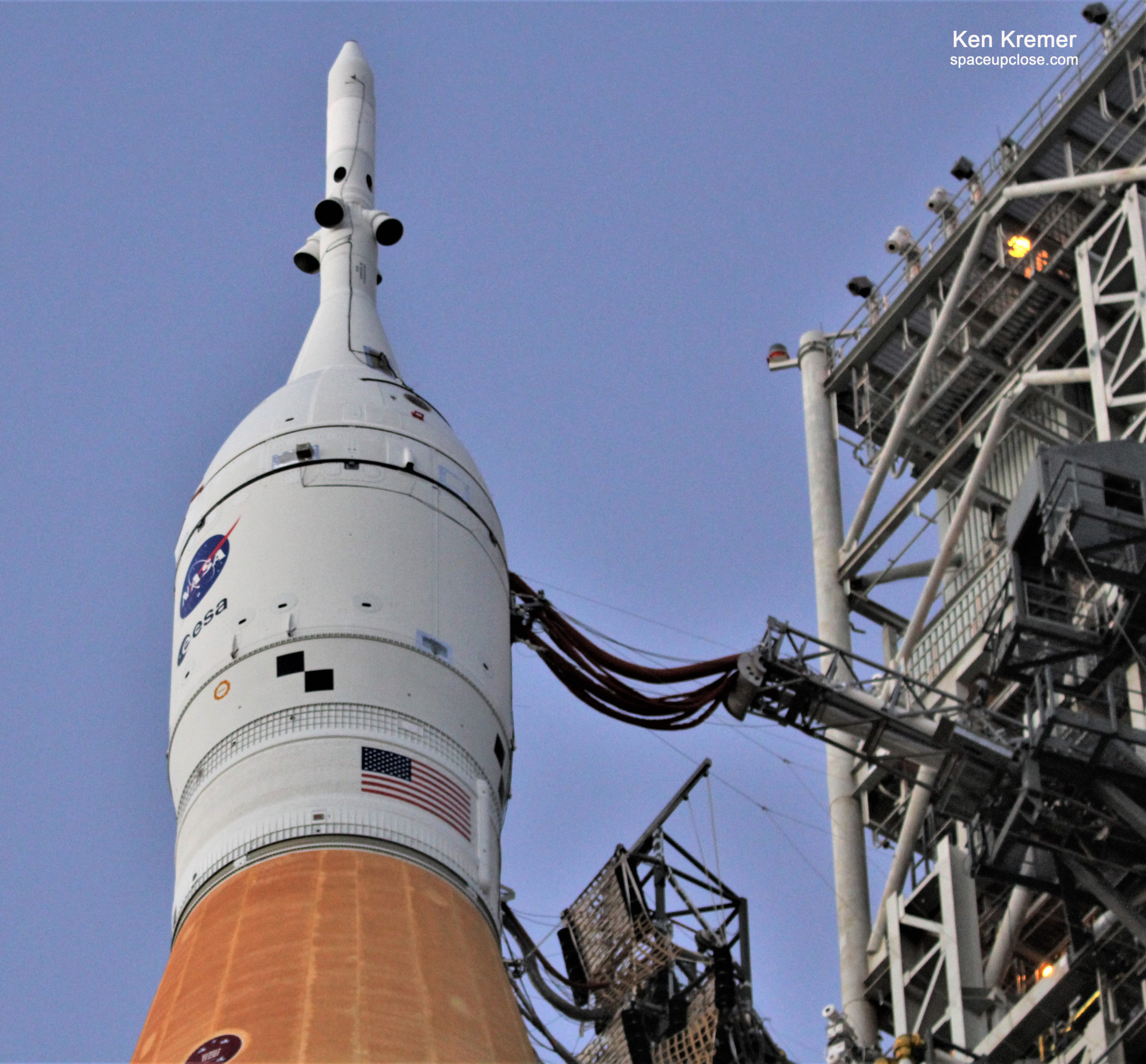
Following a successful WDR campaign the SLS/Orion will roll back to the VAB for data reviews, final checkouts and refurbishments before the Artemis 1 launch campaign commences.
NASA will announce a target launch date for Artemis 1 after thoroughly analyzing all the WDR test results.
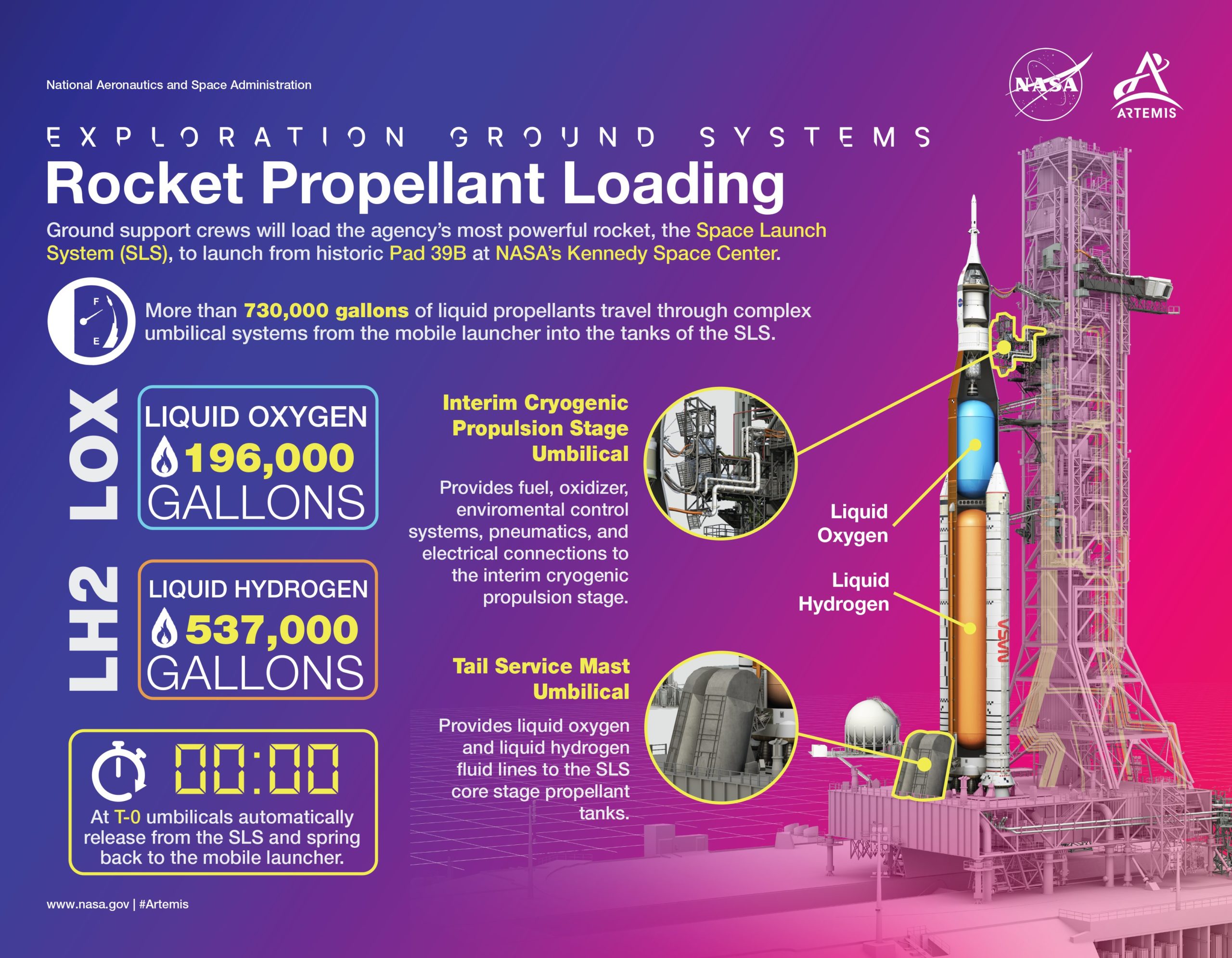
Here is the nominal countdown and propellant fueling milestone schedule from NASA:
The following activities will occur for the Space Launch System (SLS) rocket, the Orion spacecraft, and supporting ground systems:
Prior to Call to Stations
- The Orion crew module hatch is closed (will occur at ~L-37.5 hours for launch)
- The crew access arm is retracted (will occur at ~L-30 hours for launch)
- Leak checks are completed on the Orion spacecraft and the launch abort system is closed (will occur at ~L-29 hours, 30 minutes for launch)
5 p.m., April 1 – L-45 hours and counting
- The launch team arrives on their stations and the countdown begins (L-45, 40 minutes hours)
- Fill the water tank for the sound suppression system (L-45 hours)
- The Orion spacecraft powered up start (L-41 hours)
- May be powered earlier during the test
- The SLS core stage is powered up (L-35 hours, 20 minutes)
- Final preparations of the four RS-25 engines complete (L-30 hours, 30 minutes)
- Engines will not fire during this test
- Side flame deflectors are moved into place (L-21 hours)
1:40 a.m., April 3 – L-13 hours and counting
- The SLS interim cryogenic propulsion stage (ICPS) is powered up (L-12 hours, 50 minutes)
- All non-essential personnel leave Launch Complex 39B (L-12 hours)
6 a.m. – L-8 hours, 40 minutes and counting
- Built in countdown hold begins and lasts approximately 1.5 hours (L-8 hours, 40 minutes)
- The launch director and mission management team chair conduct a weather and tanking briefing (L-8 hours, 20 minutes)
- The launch director and mission management team chair decide if they are “go” or “no-go” to begin tanking the rocket (L-7 hours, 50 minutes)
6:40 a.m. – L-8 hours and counting
- 7:20 a.m.: Core stage LOX chilldown start (L-7 hours, 20 minutes)
- 8:15 a.m.: Core stage LOX slow fill start (L-6 hours, 25 minutes)
- 8:30 a.m.: Core stage LOX fast fill start (L-6 hours, 10 minutes)
- 8:35 a.m.: Core stage LH2 chilldown start (L-6 hours, 5 minutes)
- 8:40 a.m.: Core stage LH2 slow fill start (L-6 hours)
- 9:00 a.m.: Core stage LH2 fast fill start (L-5 hours, 40 minutes)
10:10 a.m. – L-4 hours, 30 minutes and counting
- 10:10 a.m.: Core stage LH2 topping start (L-4 hours, 30 minutes)
- 10:15 a.m.: ICPS LH2 chilldown (L-4 hours, 25 minutes)
- 10:15 a.m.: Core stage LH2 replenish start (L-4 hours 25 minutes)
- 10:20 a.m.: Orion communications system activation start (RF to Mission control) (L-4 hours, 20 minutes)
- 10:40 a.m.: ICPS LH2 fast fill (L-4 hours)
11:10 a.m. – L-3 hours, 30 minutes and counting
- 11:15 a.m.: Core stage LOX topping start (L-3 hours, 25 minutes)
- 11:20 a.m.: Core stage LOX replenish start (L-3 hours, 20 minutes)
- 11:20 a.m.: ICPS LOX chilldown start (L-3 hours, 20 minutes)
- 11:25 a.m.: ICPS LH2 validation and leak test start (L-3 hours, 15 minutes)
- 11:40 a.m.: ICPS LH2 tanks load topping start (L-3 hours)
- 11:40 a.m.: ICPS/SLS telemetry data verified with mission control and SLS Engineering Support Center (L-3 hours)
- 12 p.m.: ICPS LH2 replenish start (L-2 hours, 40 minutes)
- 12 p.m.: ICPS LOX validation and leak test (L-2 hours, 40 minutes)
- 12:20 p.m.: ICPS LOX topping start (L-2 hours, 20 minutes)
- 12:30 p.m.: ICPS LOX replenish start (L-2 hours, 10 minutes)
- 12:40 p.m.: WDR-specific core stage LOX/LH2 stop flow and recover test (L-2 hours through L-55 minutes)
2 p.m. – L-40 minutes and holding
- 2 p.m.: Final NASA Test Director briefing is held
- 2 p.m.: Built in 30-minute countdown hold begins
- 2:25 p.m.: The launch director polls the team to ensure they are “go” for terminal count for test purposes
2:30 p.m. – T-10 minutes and counting (WDR Run 1)
- 2:34 p.m.
- Orion ascent pyros are armed (T-6 minutes)
- Orion set to internal power (T-6 minutes)
- Core Stage LH2 terminate replenish (T-5 minutes, 57 seconds)
- 2:36 p.m.
- Core Stage auxiliary power unit starts (T-4 minutes)
- Core stage LOX terminate replenish (T-4 minutes)
- ICPS LOX terminate replenish (T-3 minutes, 30 seconds)
- 2:38 p.m.
- ICPS switches to internal battery power (T-1 minute, 56 seconds)
- Core stage switches to internal power (T-1 minute, 30 seconds)
- ICPS enters terminal countdown mode (T-1 minute, 20 seconds)
- 2:39 p.m.
- ICPS LH2 terminate replenish (T-50 seconds)
- Ground launch sequencer sends “cut-off” command (T-33 seconds)
Perform Critical Safing and Planned Recycle back to T-10 minutes and holding (takes approximately one hour)
T-10 minutes and counting (WDR Run 2)
- Orion ascent pyrotechnics are armed (T-6 minutes)
- Orion set to internal power (T-6 minutes)
- Core Stage LH2 terminate replenish (T-5 minutes, 57 seconds)
- Core Stage auxiliary power unit starts (T-4 minutes)
- Core stage LOX terminate replenish (T-4 minutes)
- ICPS LOX terminate replenish (T-3 minutes, 30 seconds)
- ICPS switches to internal battery power (T-1 minute, 56 seconds)
- Core stage switches to internal power (T-1 minute, 30 seconds)
- ICPS enters terminal countdown mode (T-1 minute, 20 seconds)
- ICPS LH2 terminate replenish (T-50 seconds)
- Ground launch sequencer sends “Go for automated launch sequencer” command (T-33 seconds)
- Core stage flight computer to automated launching sequencer (T-30 seconds)
- Ground launch sequencer manual cut-off at T-9.34 seconds
Proceed with Critical Safing Operations
Proceed with Core Stage and ICPS Cryogenic Fuel Drain Operations
….
Years in the making NASA’s SLS Moon rocket is destined to return American astronauts to the lunar surface for the first time in over 50 years later this decade.
SLS is the most powerful rocket NASA has ever built, generating some 8.8 million pounds of liftoff thrust at ignition – about 15% more powerful than NASA’s legendary Saturn V that hurled the first humans to land on the Moon back in 1969 on the Apollo 11 moon landing mission.
The maiden SLS/Orion rocket rolled to the pad Thursday, March 17 for the critical WDR fueling and countdown demonstration test – which is the final major final fueling test before launch.
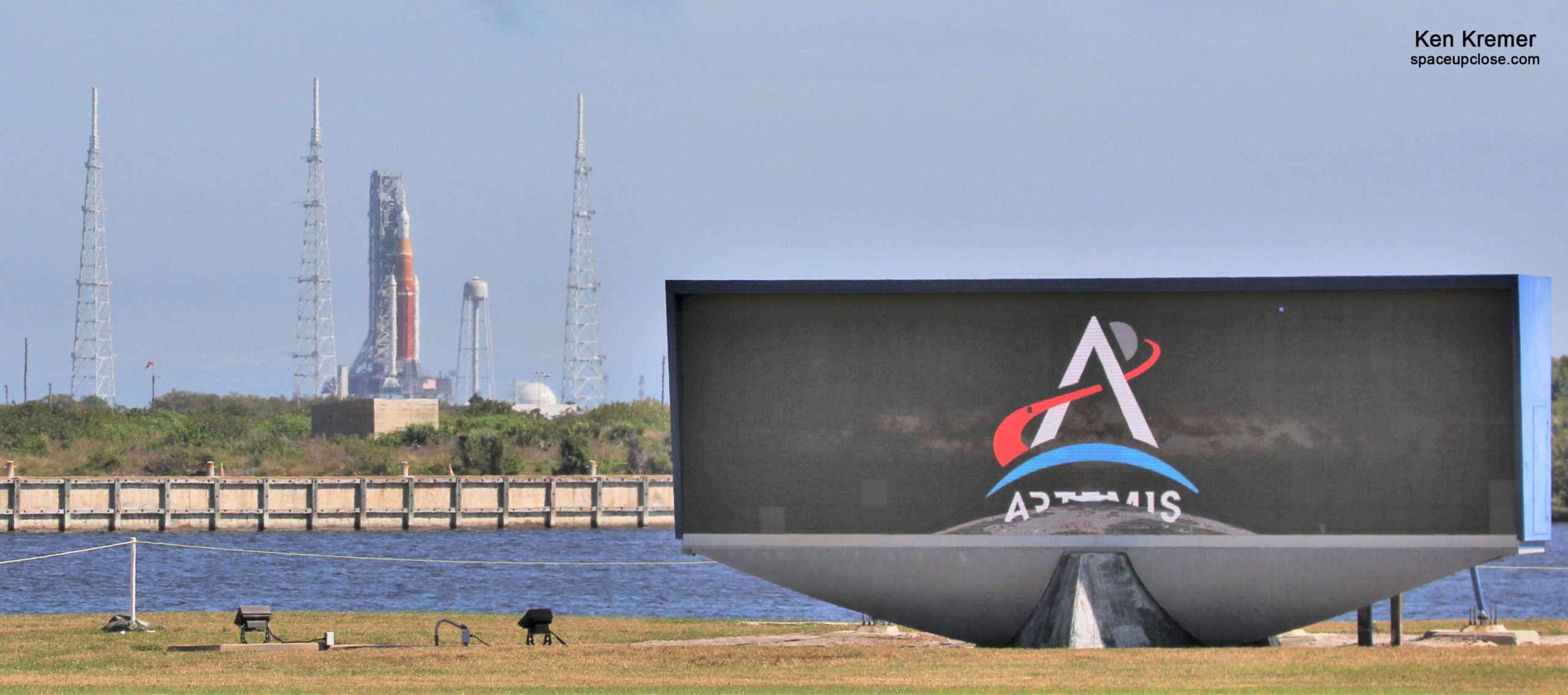
Liftoff of the uncrewed Artemis 1 mission is slated for no earlier than June 2022 from Launch Complex 39B at NASA KSC on the first in a series of increasingly complex missions to test the SLS heavy lift mega rocket and Orion crew capsule as an integrated system prior to crewed flights to the Moon starting with Artemis 2 – targeting launch in 2024.
SLS 1 will launch the Orion crew spacecraft on the Artemis 1 mission lasting between 4 to 6 weeks on a journey of some 280,000 miles (450,000 kilometers) from Earth to many thousands of miles past the moon and then return to Earth.
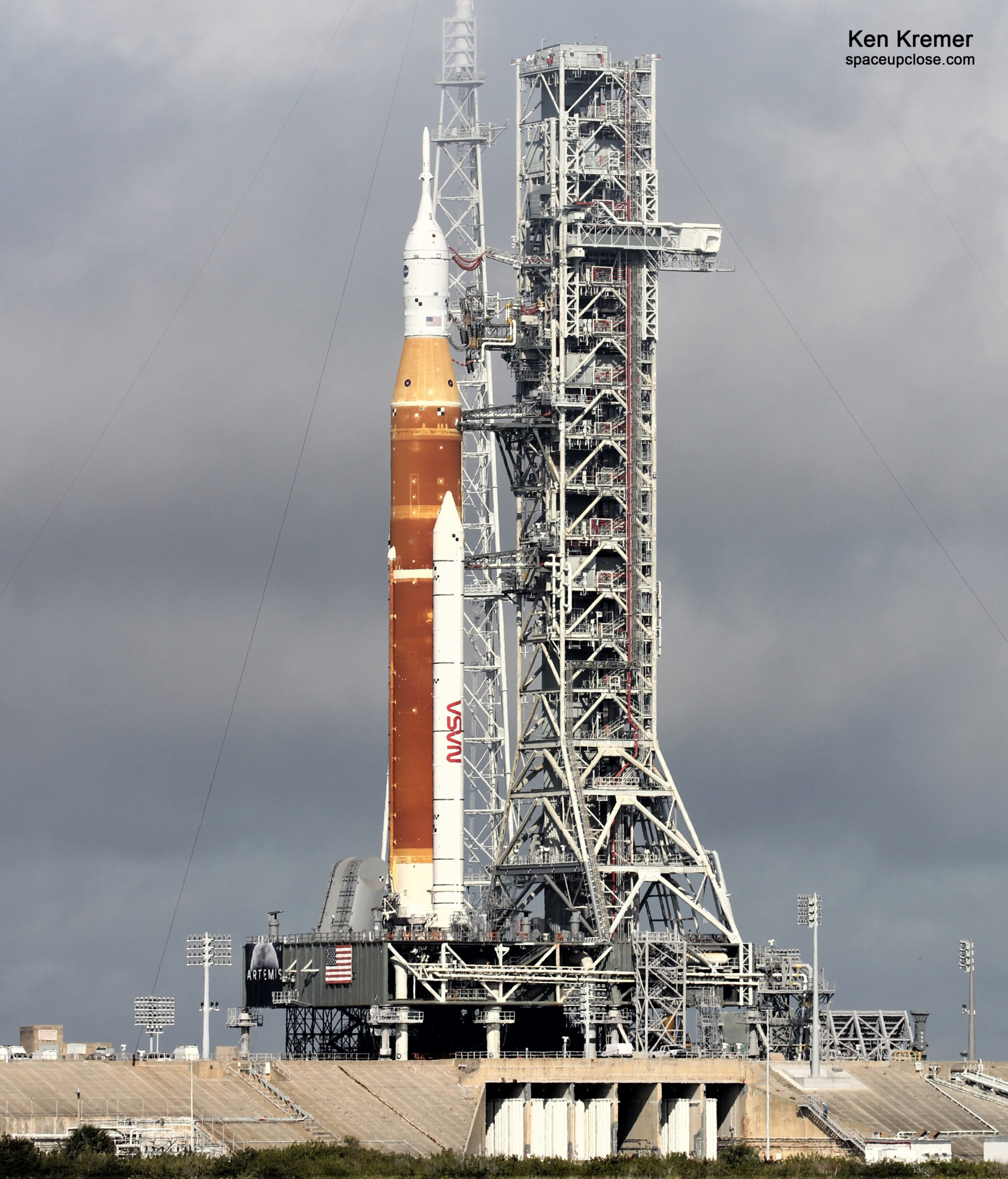
Delays to completing the SLS WDR demo test are impacting two upcoming SpaceX Crew Dragon launches to ISS that are already delayed several times to NET April 8 & April 20
Further launch delays can be expected.
Ken’s WDR demo test commentary featured on Fox 35 Orlando TV news on April 4:
https://www.fox35orlando.com/news/nasa-resumes-artemis-i-wet-dress-rehearsal-countdown
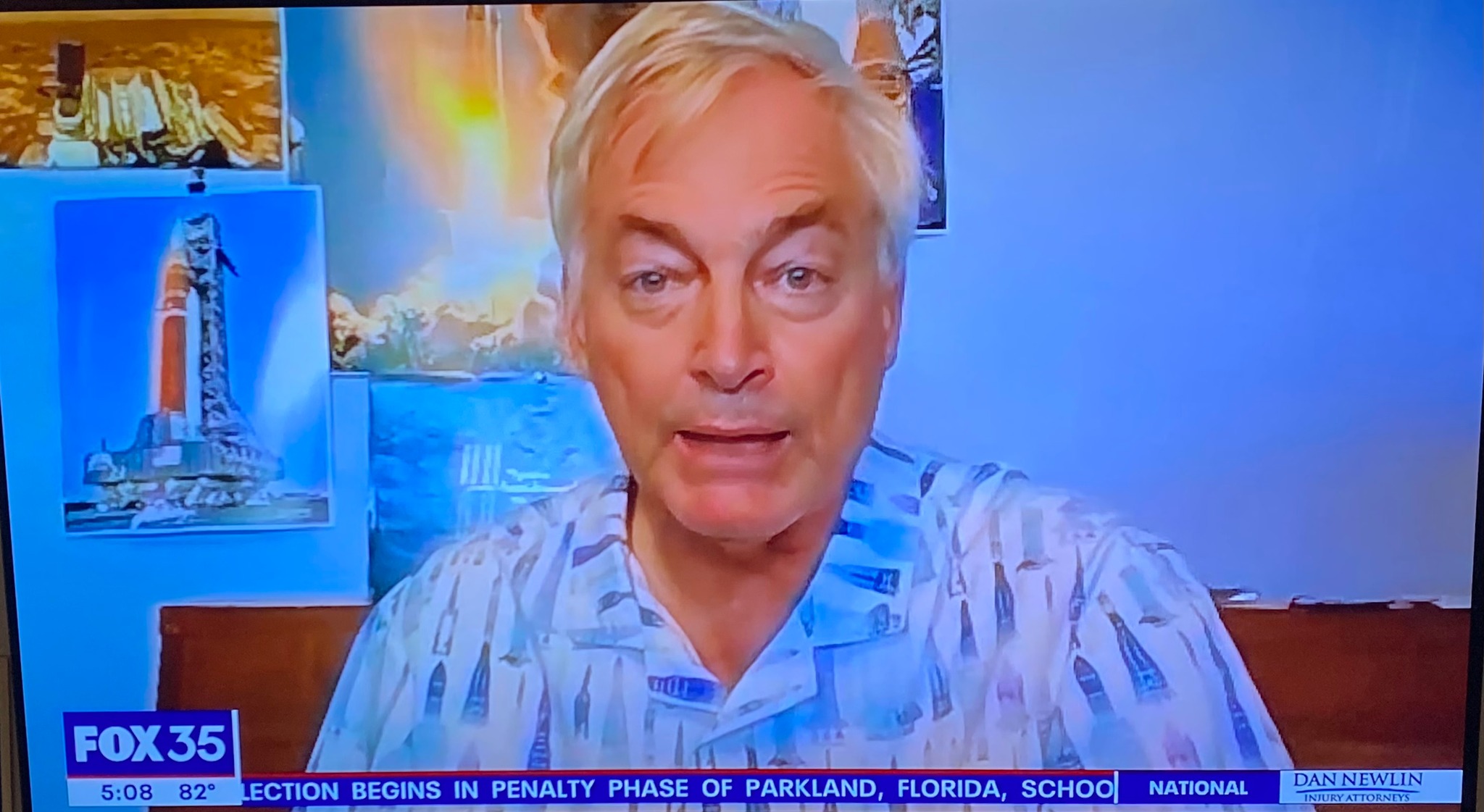
WFTV Channel 9 ABC News Orlando featured Ken‘s pre-rollout commentary about how critical NASA’s Space Launch System Artemis 1 launch to the Moon is to NASA – with 1st ever rocket rollout to pad 39B just completed at NASA’s Kennedy Space Center
WFTV Channel 9 ABC News Orlando also featured Ken’s post rollout comments about busy times on the Space Coast with SLS WDR and upcoming Artemis 1 launch and two SpaceX Crew Dragon launches to ISS NET April 8 & April 20 and NASA astronaut Mark Vande Hei return on a Russian Soyuz after working 1 year aboard the International Space Station (ISS):
https://www.wftv.com/news/local/look-space-coasts-busy-week-ahead/GSYWA2VOHFEHDG35OGCERHT7AI/
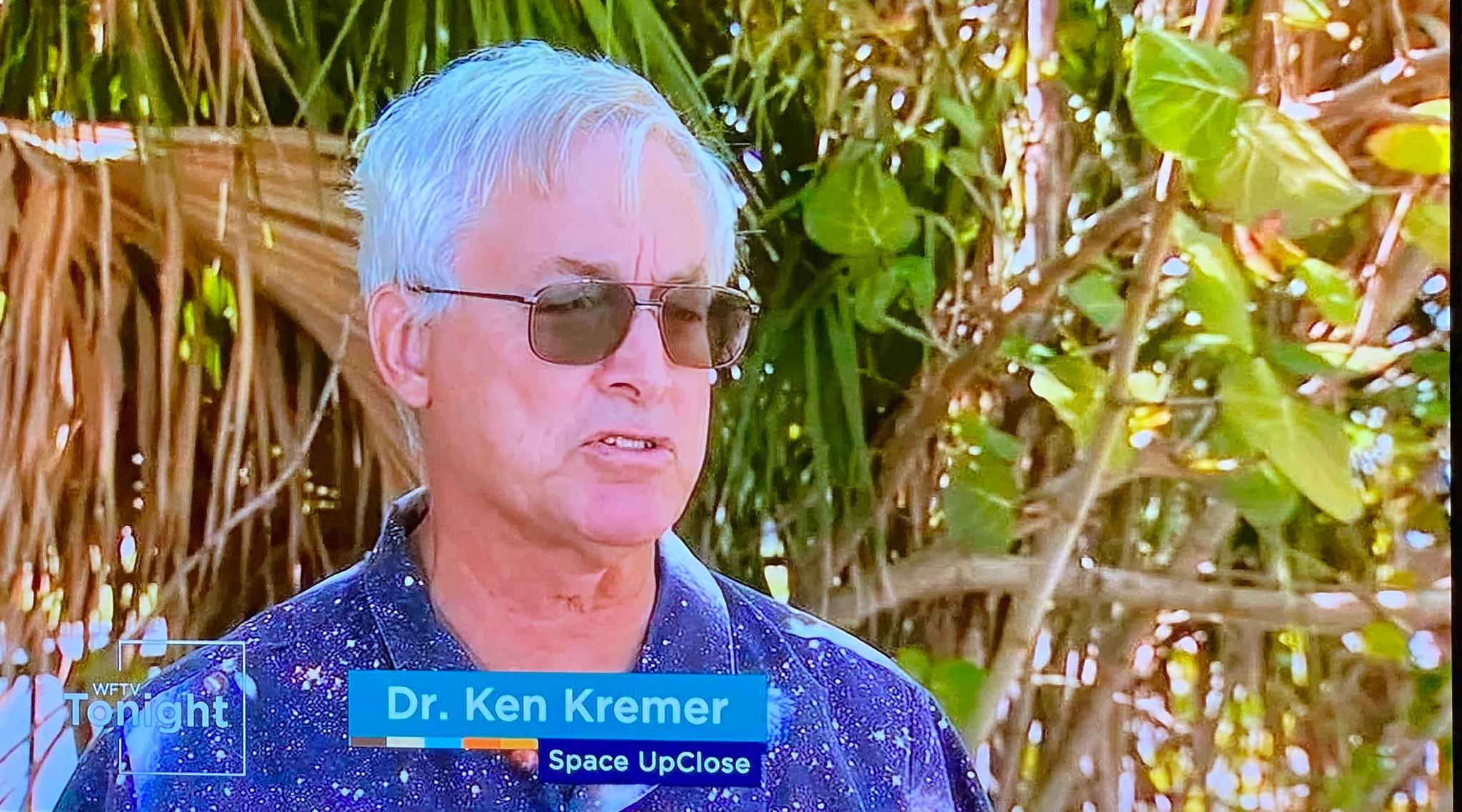
Watch the guest appearance by Ken Kremer & Jean Wright on ‘Stay Curious’ on March 25 at American Space Museum about SLS Artemis 1 Moon rocket rollout to pad 39B with my up close photos:
https://www.facebook.com/SpaceWalkOfFame/videos/644149686687128
Watch Ken’s continuing reports about Artemis, SLS, Orion and NASA missions, JWST, IXPE, DART, Lucy Asteroid mission, GOES, SpaceX Cargo and Crew Dragons, SpaceX Starlink, Commercial Crew and Starliner and Crew Dragon, Blue Origin and Space Tourism, and onsite for live reporting of upcoming and recent SpaceX and ULA launches including Crew 1 & 2 & 3, ISS, Solar Orbiter, Mars 2020 Perseverance and Curiosity rovers, NRO spysats and national security missions and more at the Kennedy Space Center and Cape Canaveral Space Force Station.
Stay tuned here for Ken’s continuing Earth and Planetary science and human spaceflight news: www.kenkremer.com –www.spaceupclose.com – twitter @ken_kremer – email: ken at kenkremer.com
Dr. Kremer is a research scientist and journalist based in the KSC area, active in outreach and interviewed regularly on TV and radio about space topics.
………….
Ken’s photos are for sale and he is available for lectures and outreach events
Please consider supporting Ken’s work by purchasing his photos and/or donating at Patreon:
https://www.patreon.com/kenkremer
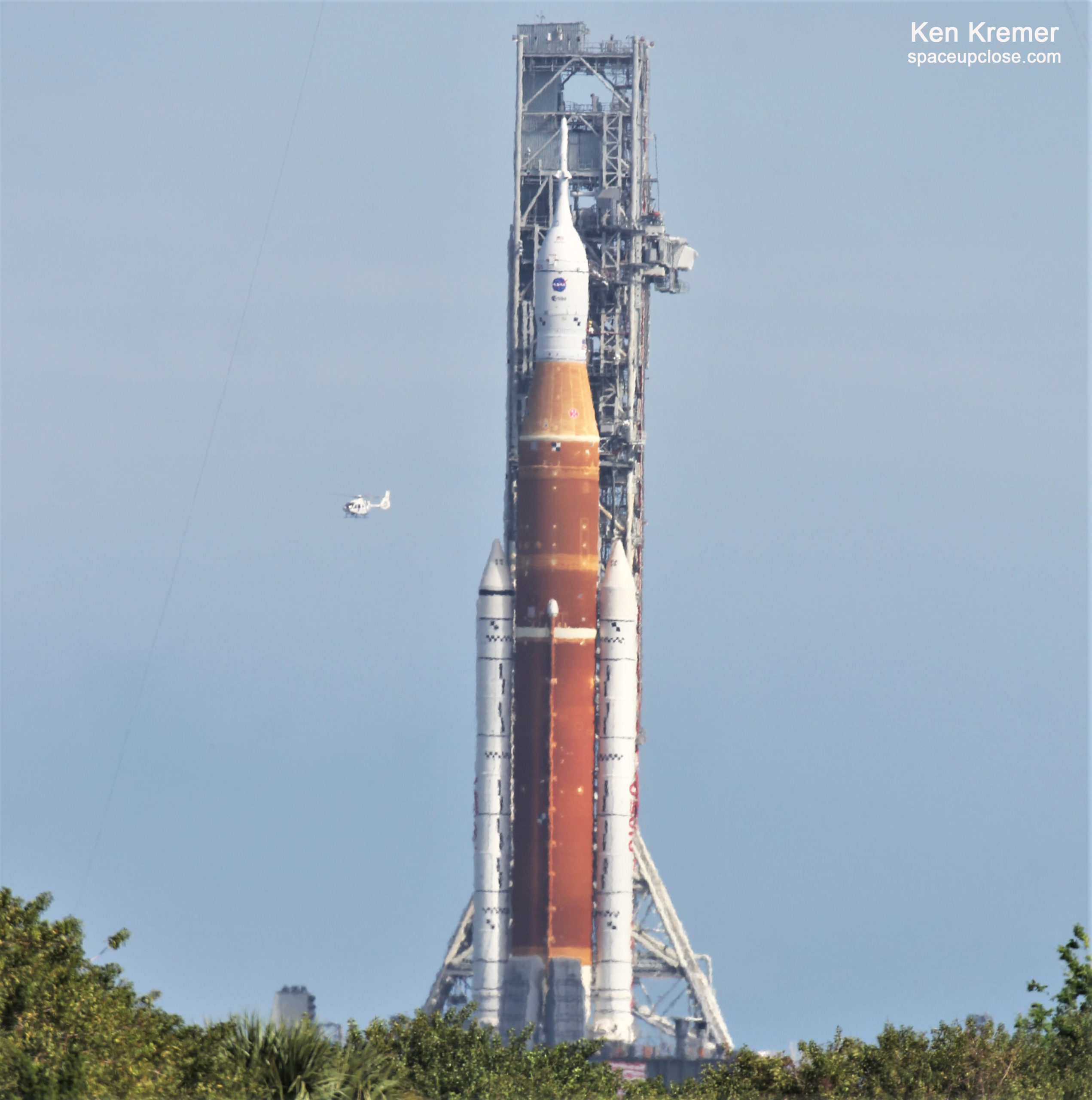
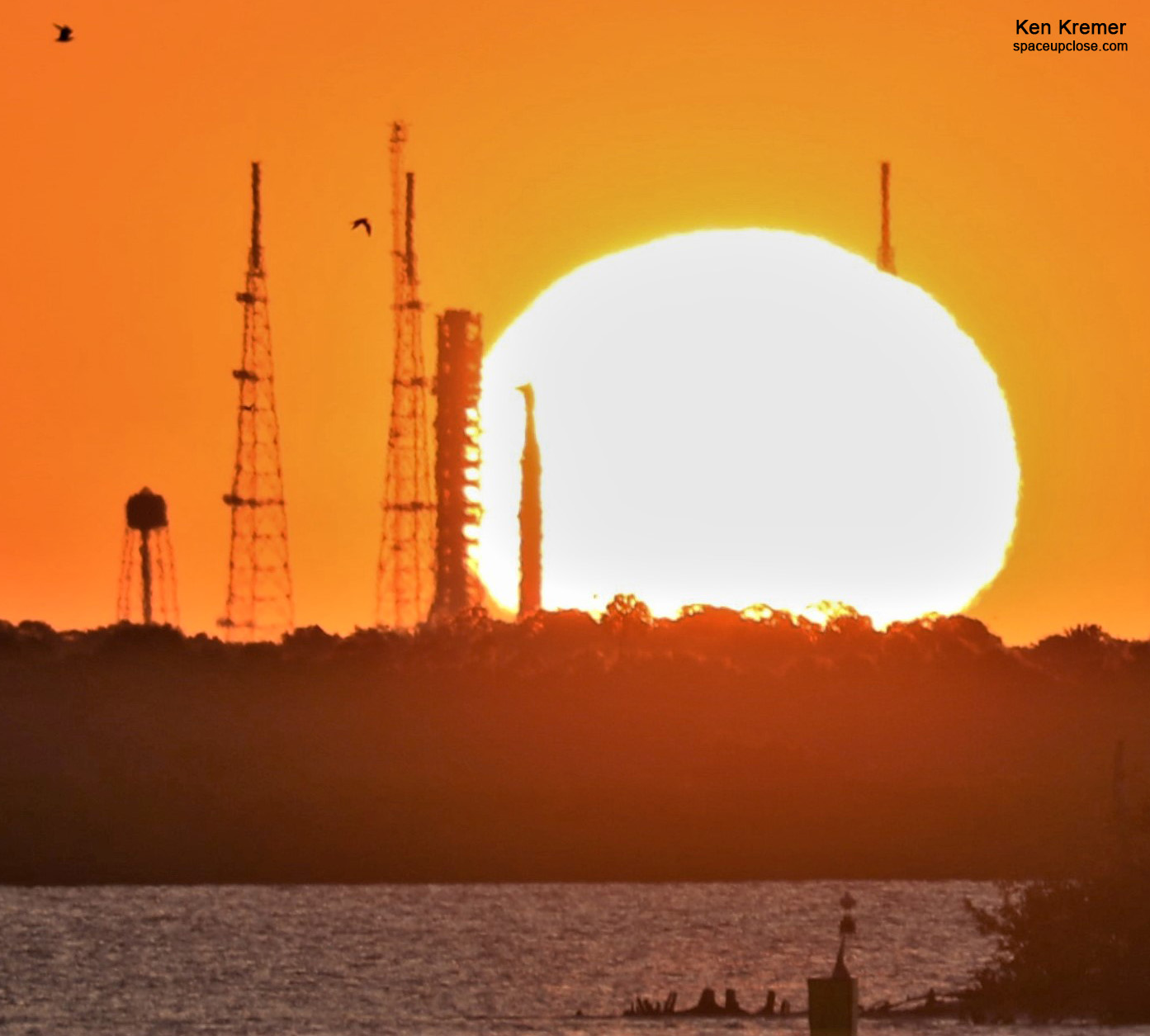
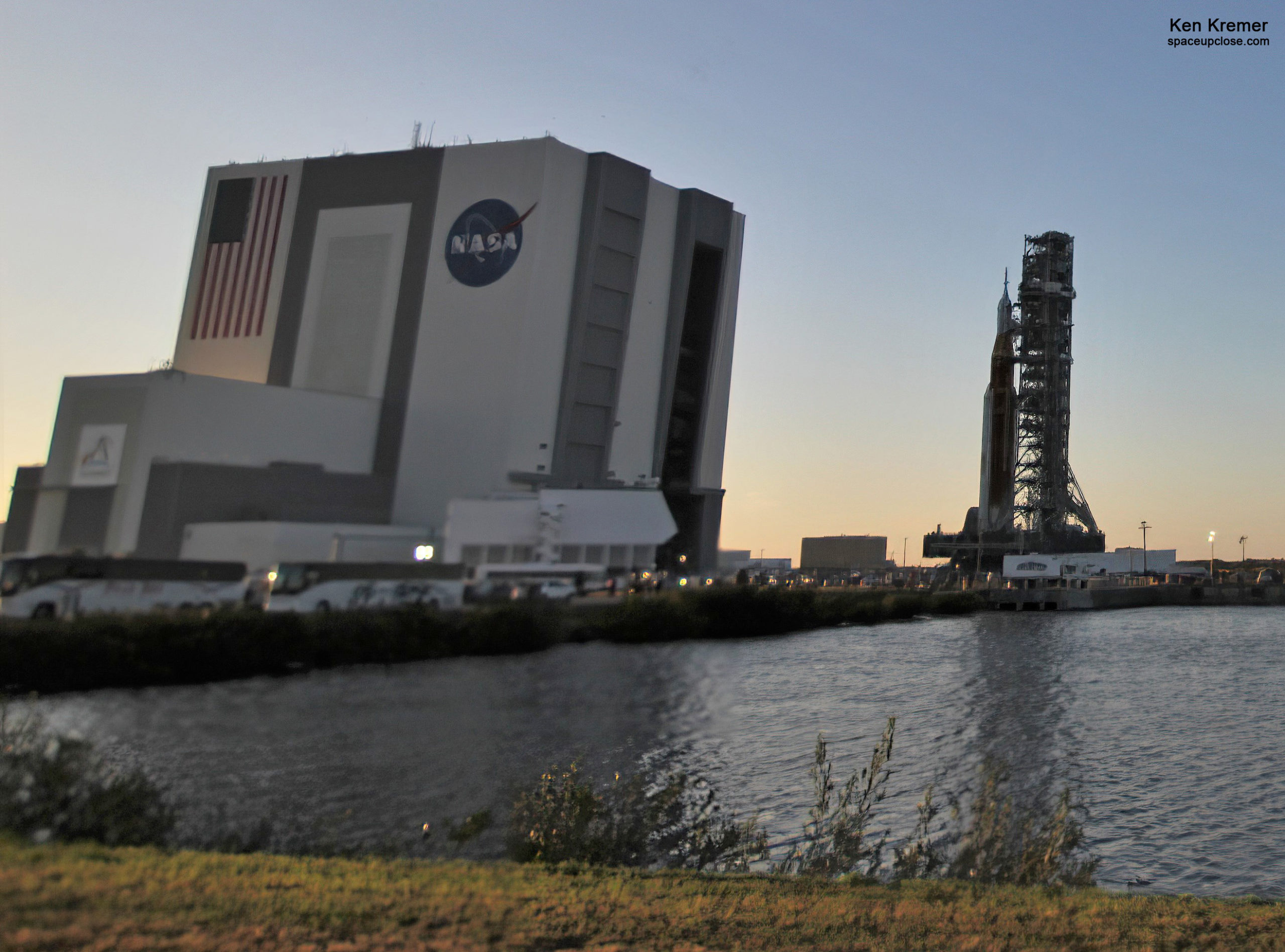
x



